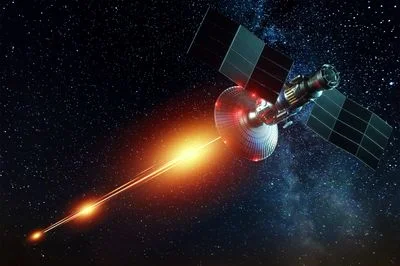
China’s Groundbreaking Laser Technology Reaches Moon in Daylight, Igniting New Space Race
China has achieved a significant leap in space technology, successfully using an infrared laser to detect a satellite orbiting the Moon during daylight. This feat, accomplished by scientists at the Chinese Academy of Science's Yunnan Observatories, marks a significant advancement in laser communication and lunar exploration. The achievement is akin to hitting a single hair from 10 kilometers (6 miles) away, highlighting the precision involved.

The laser was bounced off a retroreflector device on the Tiandu-1 satellite, which orbits the Moon at a distance of approximately 130,000 kilometers (81,000 miles) from Earth. This distance is far beyond the range of most satellites, making the achievement even more remarkable. The ability to track satellites in daylight overcomes a major limitation in laser communication technology, which has traditionally been hampered by sunlight interference.
Satellite Laser Ranging (SLR) typically involves firing nanosecond pulses from ground stations to bounce off retroreflectors on spacecraft. The returning signal reveals the distance with centimeter-level accuracy. While common for low-Earth orbit satellites, it becomes significantly harder when targeting the Moon, especially in daylight.
The development is crucial for China's ambitious lunar exploration plans, which include establishing a permanent lunar presence by 2035. The Tiandu-1 satellite, along with Tiandu-2 and the Queqiao-2 relay satellite, forms the core of China's lunar exploration infrastructure. These satellites have already provided detailed images of the lunar surface and demonstrated successful communication links, paving the way for future missions.
NASA has also used laser technology for similar purposes, with the Lunar Reconnaissance Orbiter (LRO) using its laser altimeter to find the Vikram lander of India and Japan’s Smart Lander for Investigating Moon (SLIM) on the Moon's surface. However, these operations were conducted at a much shorter distance (100 kilometers) compared to China's achievement. As Xiaoli Sun from NASA’s Goddard Space Flight Center stated, LRO’s altimeter wasn’t designed for this specific application, making the chances of pinpointing a tiny retroreflector on the Moon’s surface already low.
Laser communication is essential for future long-distance communication, potentially enabling high-speed data transfer to Mars. Laser communications, also known as Deep Space Optical Communications (DSOC), has been tested on the Psyche spacecraft, delivering significantly higher data rates than conventional radio waves. However, daylight limitations have been a significant hurdle.
China's success in overcoming this barrier could accelerate the deployment of laser communication systems for deep-space missions. DSEL (Deep Space Exploration Laboratory) plans to extend daytime trials with higher ranges and repetition rates, aiming at seamless integration with deep-space operations. This comes after the successful 2024 launch of Chang’e-6, which brought back soil samples from the Moon’s far side, emphasizing the need for space exploration, communication, and navigation systems.
This breakthrough inevitably raises questions about future international cooperation and competition in space. As China continues to push the boundaries of space exploration, how will other nations respond? Will this lead to increased collaboration or a more intense space race? Only time will tell.
What are your thoughts on the implications of China's achievement for the future of space exploration? Share your opinions in the comments below.